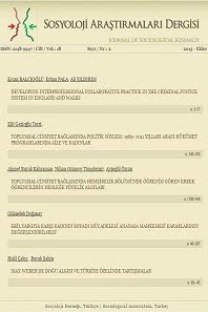THE EXAMINATION ABOUT KNIFE USING BEHAVIORS OF YOUTH WITH REGARD TO VARIOUS VARIABLES DURING A FIGHT (SIVAS EXAMPLE)
___
- Alikaşifoğlu, M.; Ercan, O.; Erginöz, E.; Kaymak, D. (2004). Violent behavioramong turkish high school students and correlate of physicalfighting. European Journal of PublicHealth, 14 (2), 173-177. Aras, Ş.; Günay, T.; Özan, S.; Orçin, E. (2007). İzmir ilinde lise öğrencilerinin riskli davranışları. Anadolu Psikiyatri Dergisi, 8 (3), 186-196. Avcı, A. (2010). Eğitimde şiddet olgusu, Lise öğrencilerinde şiddet, saldırganlık ve ahlaki tutum ilişkisi: Küçükçekmece ilçesi örneği. Unpublished Doctoral Thesis, Marmara üniversitesi, İstanbul. Avcı, A. (2010-b). Aile yapı ve atmosferinin okul şiddetine etkisi. Değerler Eğitimi Dergisi, 8 (19), content/img/PDF_Makaleler/ ahmet_avci_ded1.pdf (01/06/2016). Avrupa Konseyi. (2002). Okullarda şiddetin önlenmesi ve şiddetle mücadele için yerel ortaklıklar konferansı sonuç bildirgesi. Strasbourg. http://www.meb.gov.tr/ (11/11/2016). Ayan, S. (2007). Aile içinde çocuğa yönelik şiddet: Sivas ilköğretim ikinci kademe öğrencileri üzerine bir inceleme. Unpublished Doctoral Thesis, Cumhuriyet üniversitesi, Sivas. Aygen, M. (2009). Elazığ ilinde gençlerde şiddete başvurma yada maruz kalma sıklığı, etkileyen faktörler ve öfke ile ilişkisi. Unpublished Doctoral Thesis, Fırat üniversitesi, Elazığ. Balkıs, M.; Duru, E.; Buluş, M. (2005). Şiddete yönelik tutumların özyeterlik, medya, şiddete yönelik inanç, arkadaş grubu ve okula bağlılık duygusu ile ilişkisi. Ege Eğitim Dergisi, (6), 2, 81-97. Baş, A.; Öz, S.; Kabasakal Z. (2012). İlköğretim ve ortaöğretim okullarında reaktif ve proaktif saldırganlık. Mehmet Akif Ersoy Üniversitesi Eğitim Fakültesi Dergisi, 12 (23), 354-370. Diepold, B.; Krannıch, S.; Sanders, M. (1997). Uber aggression und gewalt bei kindern in unterschiedlichen kontexten. Praxis Kinderpsychologie und Kinderpsychiatrie, 46, 153-168. Dingfelder, F. S. (2010). Ending an Epidemic. http://www.apa.org/ monitor/2010/03/epidemic. Aspx adresinden erişildi. Gökdaş, İ. (2007). İlköğretimde şiddet. Editör: A. Solak. Okullarda Şiddet ve Çocuk Suçluluğu içinde (s. 263-295). Ankara: Hegem Yayınları. Incanews (2016). Amerika’da Silahlanma ve Suç İstatistikleri, www.incanews.net/dosya Kitzmann, K.; Gaylord, K. (2003). Child witnesses to domestic violence: A Meta-Analytic review. Journal of Consulting and Clinical Psychology, 71 (2), 339-352. Koç, B. (2011). Okullarda Şiddet (2. Baskı). İstanbul: e yazı yayınları. Kulaksızoğlu, A. (1998). Ergenlik Psikolojisi. İstanbul: Remzi Yayınevi. Haskan, Ö.; Yıldırım, İ. (2012). Şiddet eğilimi ölçeğinin geliştirilmesi. Eğitim ve Bilim, 37, (163) 165-177. Lowry, R.; Powell, K. (1998). Weapen carying, physical fightihg, and fight-related injury among. U.S adolescents, Prev med, 14, 122-129. Özcebe, H.; Çetik, H.; Üner, S. (2006). Adölesanlarda şiddet davranışları. Okul ve Çevresinde Çocuğa Yönelik Şiddet ve Alınabilecek Tedbirler Uluslararası Sempozyum Bildiri Özetleri. İstanbul: Duman Ofset. Özgür, G.; Yörükoğlu, G.; Arabacı, L. (2011). Lise öğrencilerinin şiddet algıları, şiddet eğilim düzeyleri ve etkileyen faktörler. Psikiyatri Hemşireliği Dergisi, 2 (2), 53-60. Schrumpf, F.; Crawford, D.; Bodıne, R. (2007). Okulda Çatışma Çözme ve Akran Arabuluculuk, (çev: F.G. Akbalık, B.D. Karaduman). Ankara: İmge Kitabevi. Smith, D. L.; Smith, B. J. (2006). Perceptions of violence: The views of teachers who left urban schools, The High School Journal, 34-42. T.C. Başbakanlık. (1998). Aile İçinde ve Toplumsal Alanda Şiddet. Ankara: Başbakanlık Basımevi. Türkiye Ergen Profili Araştırması 2013 (2014). T.C. Aile e Sosyal Politikalar Bakanlığı. Ankara: Uzerler Matbaacılık. UNFPA. (2013). Kadına yönelik aile içi şiddet konusunda ilköğretim ikinci kademe ve lise öğrencilerinin tutumları: Ankara, Erzurum ve Aydın illerinde niteliksel bir araştırma, Ankara: Uzerler Matbaacılık. Valois, R. F.; Mc keown R.E. (1995). Corelates of aggressive and violent behaviors among public high school adolescents. J Adolesc Health, 16: 26-34. World Health Organızatıon. (2002). World report on violence and health, Edited by Etienne G. Krug ... [et al.], Geneva, Switzerland.
- ISSN: 2148-9947
- Yayın Aralığı: 2
- Başlangıç: 2010
- Yayıncı: Sosyoloji Derneği
KÜLTÜREL ÇEŞİTLİLİĞİN YÖNETİM MODELLERİ ÜZERİNE BİR İNCELEME: İLTİCA VE GÖÇ ULUSAL EYLEM PLANI
YENİ BİR DİL YENİ CİNSİYET DÜZENİ
SINGLE MOTHERS DOING FAMILY: RE-FORMING TRADITIONAL FAMILY IN TURKEY
İÇERİDEKİ SES: SUÇA YÖNELMİŞ BİREYLERİN GÖZÜNDEN DENETİMLİ SERBESTLİK UYGULAMALARI
ÖZNELERİN GÖZÜNDEN VE DİLİNDEN AİLENİN TOPLUMSAL OLARAK İNŞASINA FENOMENOLOJİK BİR YAKLAŞIM
YENİ TEKNOLOJİ UYGULAMALARININ GENÇ ÇIRAKLARIN İSTİHDAMLARINA ETKİSİ: SİTELER MOBİLYA SEKTÖRÜ ÖRNEĞİ
Çağdaş Ümit YAZGAN, Nadir SUĞUR
